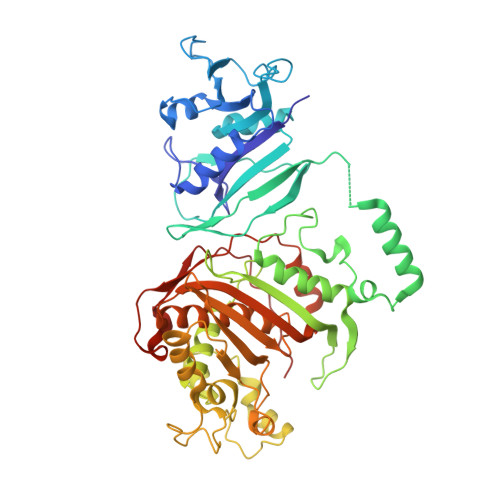Exploring novel strategies for AIDS protozoal pathogens: alpha-helix mimetics targeting a key allosteric protein-protein interaction in C. hominis TS-DHFR.
Martucci, W.E., Rodriguez, J.M., Vargo, M.A., Marr, M., Hamilton, A.D., Anderson, K.S.(2013) Medchemcomm 4: 1247-1256
- PubMed: 24324854
- DOI: https://doi.org/10.1039/C3MD00141E
- Primary Citation of Related Structures:
3HJ3 - PubMed Abstract:
The bifunctional enzyme thymidylate synthase-dihydrofolate reductase (TS-DHFR) from the protozoal parasite Cryptosporidium hominis is a potential molecular target for the design of antiparasitic therapies for AIDS-related opportunistic infections. The enzyme exists as a homodimer with each monomer containing a unique swap domain known as a "crossover helix" that binds in a cleft on the adjacent DHFR active site. This crossover helix is absent in species containing monofunctional forms of DHFR such as human. An in-depth understanding of protein-protein interactions between the crossover helix and adjacent DHFR active site that might modulate enzyme integrity or function would allow for insights into rational design of species-specific allosteric inhibitors. Mutational analysis coupled with structural studies and biophysical and kinetic characterization of crossover helix mutants identifies this domain as essential for full enzyme stability and catalytic activity, and pinpoints these effects to distinct faces of the crossover helix important in protein-protein interactions. Moreover, targeting this helical protein interaction with α-helix mimetics of the crossover helix leads to selective inhibition and destabilization of the C. hominis TS-DHFR enzyme, thus validating this region as a new avenue to explore for species-specific inhibitor design.
Organizational Affiliation:
Department of Molecular Biophysics and Biochemistry, Yale University School of Medicine, 333 Cedar Street, New Haven, Connecticut 06520, USA ; Department of Pharmacology, Yale University School of Medicine, 333 Cedar Street, New Haven, Connecticut 06520, USA.


















